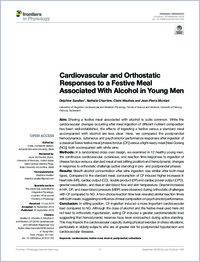Cardiovascular and orthostatic responses to a festive meal associated with alcohol in young men
- Sarafian, Delphine Laboratory of Integrative Cardiovascular and Metabolic Physiology, Faculty of Science and Medicine, University of Fribourg, Switzerland
- Charrière, Nathalie Laboratory of Integrative Cardiovascular and Metabolic Physiology, Faculty of Science and Medicine, University of Fribourg, Switzerland
- Maufrais, Claire Laboratory of Integrative Cardiovascular and Metabolic Physiology, Faculty of Science and Medicine, University of Fribourg, Switzerland
- Montani, Jean-Pierre Laboratory of Integrative Cardiovascular and Metabolic Physiology, Faculty of Science and Medicine, University of Fribourg, Switzerland
- 30.09.2019
Published in:
- Frontiers in Physiology. - 2019, vol. 10, p. 1183
English
Aim: Sharing a festive meal associated with alcohol is quite common. While the cardiovascular changes occurring after meal ingestion of different nutrient composition has been well-established, the effects of ingesting a festive versus a standard meal accompanied with alcohol are less clear. Here, we compared the postprandial hemodynamics, cutaneous and psychomotor performance responses after ingestion of a classical Swiss festive meal [cheese fondue (CF)] versus a light ready-meal [Nasi Goreng (NG)], both accompanied with white wine.Methods: In a randomized cross over design, we examined in 12 healthy young men, the continuous cardiovascular, cutaneous, and reaction time responses to ingestion of cheese fondue versus a standard meal at rest (sitting position) and hemodynamic changes in response to orthostatic challenge (active standing) in pre- and postprandial phases.Results: Breath alcohol concentration after wine ingestion was similar after both meal types. Compared to the standard meal, consumption of CF induced higher increases in heart rate (HR), cardiac output (CO), double product (DP) and cardiac power output (CPO), greater vasodilation, and rises in skin blood flow and skin temperature. Greater increases in HR, DP, and mean blood pressure (MBP) were observed during orthostatic challenges with CF compared to NG. A two-choice reaction time task revealed similar reaction times with both meals, suggesting no influence of meal composition on psychomotor performance.Conclusion: In sitting position, CF ingestion induced a more important cardiovascular load compared to NG. Although the dose of alcohol and the festive meal used here did not lead to orthostatic hypotension, eating CF induced a greater cardiometabolic load suggesting that hemodynamic reserves have been encroached during active standing. This may impede the cardiovascular capacity during physical exercise or stress situations, particularly in elderly subjects who are at greater risk for postprandial hypotension and cardiovascular diseases.
- Faculty
- Faculté des sciences et de médecine
- Department
- Département de Médecine
- Language
-
- English
- Classification
- Biological sciences
- License
- License undefined
- Identifiers
-
- RERO DOC 327408
- DOI 10.3389/fphys.2019.01183
- Persistent URL
- https://folia.unifr.ch/unifr/documents/308085
Statistics
Document views: 117
File downloads:
- mon_cor.pdf: 109
